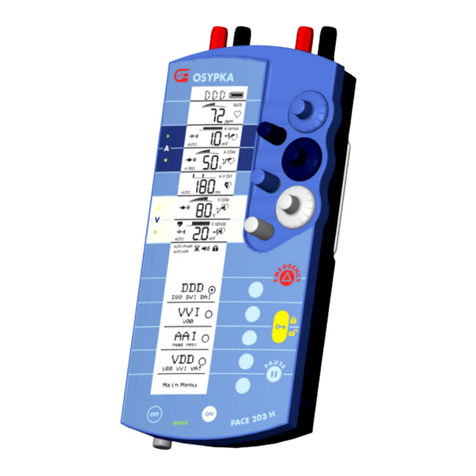
Determining the Sensitivity Threshold Manually
The sensitivity threshold can also be determined by means of the
Pause function (see User Notes "Pause Function").
Warning: For manual determination of the sensitivity threshold,
the patient must have heart activity with a rate that is
hemodynamically tolerated over a longer period of time (a few
minutes).
•Set stimulation amplitude (in dual chamber both channels) to
the smallest value so that asynchronous stimulation remains
ineffective.
•Set basic rate 10 ppm below the patient's intrinsic rate.
•In a dual chamber mode, the A-V delay must be set to a value
longer than the patient's own delay.
•In case the PACE 203H already detects heart signals, set the
sensitivity low enough (i. e. increase the sensitivity value), so
that no more sensing takes place. Thus the PACE 203H
stimulates asynchronously in the corresponding channel.
•Increase the sensitivity (decrease the sensitivity value) again
until stimulation is inhibited. This is the sensitivity threshold. In
order to create a safety cushion, the sensitivity must be further
increased. The set value should be a 1/2 to a 1/3 of the
sensitivity threshold value.
•In case a dual chamber mode is chosen the procedure must
be repeated for the other channel.
Warning: An unnecessarily high sensitivity (i.e. small sensitivity
value) increases the probability that external interference affects
the operation of the PACE 203H, which then may switch to
asynchronous stimulation.
Note: When setting the sensitivity threshold, enabling the acoustic
signal of the PACE 203H is recommended. Beeps of different
frequency distinguish acoustically between stimulation and
sensing.
Determining the Cardiac Capture Threshold
Attention: If the patient has a satisfactory intrinsic heart rate, the
determination of the sensitivity threshold must be carried out
before the cardiac capture threshold is determined. This maneuver
makes certain that no asynchronous superimposition of intrinsic
rhythm and stimulation occurs.
•Set the basic rate at least 10 ppm above the patient’s own rate.
If the PACE 203H is already effectively stimulating, lower the
stimulation amplitude until the stimulus is no longer effective.
•In case the PACE 203H is operating in a dual chamber mode,
the A-V delay must be set to a value less than the patient’s own
delay.
•Increase the stimulation amplitude slowly until the stimulus is
effective again. This is the cardiac capture threshold.
•In order to create a safety cushion, the stimulation amplitude
must be further increased. The set value should be 2 to 3 times
of the cardiac capture threshold.
•In case a dual-chamber mode is chosen, the procedure must
be repeated in the other channel.
Warning: If the PACE 203 H is to be used for a longer period of
time on a patient, the stimulation threshold should be checked
from time to time (the first time after a few hours, then daily),
because an increase in the threshold may occur.
These User Notes do not replace the Instruction for Use (IfU).
Read the IfU carefully before using the product.
Osypka Medical
5I-17-017X-B-18 P7
These User Notes do not replace the Instruction for Use (IfU).
Read the IfU carefully before using the product.
Osypka Medical
5I-17-017X-B-18 P8

























